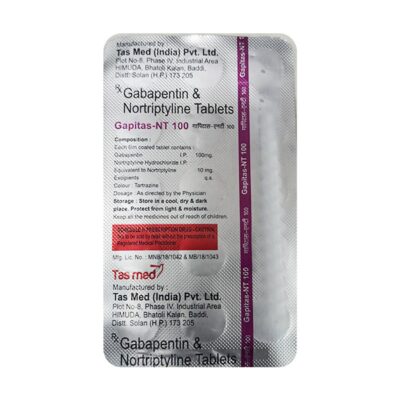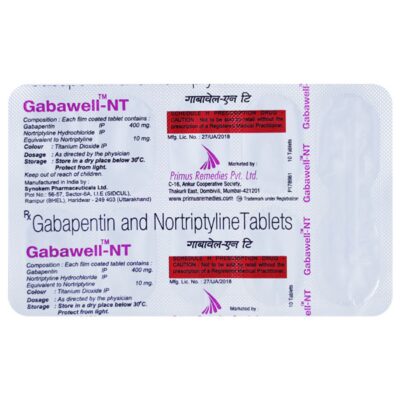Gabapentin 400 mg + Nortriptyline 10 mg Tablet
Dual-Action Relief for Neuropathic Pain and Nerve-Related Disorders
Overview
Gabapentin 400 mg + Nortriptyline 10 mg tablet is a combination medication used primarily to manage neuropathic pain, which can result from conditions like diabetes, shingles, spinal cord injury, and other nerve damage disorders. This formulation offers a synergistic effect by combining a nerve-calming anticonvulsant with a mood-stabilizing tricyclic antidepressant.
Ingredients and Their Role
-
Gabapentin (400 mg):
A gamma-aminobutyric acid (GABA) analog that modulates nerve activity and calms overexcited nerves. It helps alleviate burning, tingling, or shooting pain by acting on calcium channels in the nervous system. -
Nortriptyline (10 mg):
A tricyclic antidepressant that enhances the levels of norepinephrine and serotonin in the brain and spinal cord. It also blocks pain signals in the central nervous system, providing additional relief from chronic pain and helping with associated mood disturbances.
How to Use
-
Dosage: As prescribed by your doctor—typically once or twice daily.
-
Route: Oral, with or without food.
-
Timing: Best taken at bedtime if drowsiness occurs.
-
Do Not Stop Abruptly: Tapering is required to avoid withdrawal symptoms like irritability, dizziness, or insomnia.
Common Side Effects
These effects are usually mild and tend to reduce with time:
-
Dizziness, drowsiness, or fatigue
-
Dry mouth
-
Constipation
-
Blurred vision
-
Weight gain or increased appetite
Serious Side Effects (Seek urgent medical attention)
-
Mood changes: depression, anxiety, suicidal thoughts
-
Irregular heartbeat or chest pain
-
Severe allergic reaction: rash, itching, facial swelling
-
Urinary retention or trouble urinating
-
Seizures or tremors (rare but serious)
Monitoring & Follow-Up
-
Before Starting: Renal function, mental health assessment, ECG (if heart risk)
-
Ongoing Monitoring:
-
Neuropathic symptom relief
-
Mood and behavioral changes
-
Renal function in elderly or those with kidney disease
-
-
Frequency of Follow-Up: Initially after 2–4 weeks, then every 2–3 months
Warnings & Precautions
-
Mental Health: Monitor for suicidal thoughts or behavior changes, especially in younger patients.
-
Heart Conditions: Nortriptyline may affect heart rhythm; use with caution in patients with arrhythmias.
-
Kidney Impairment: Gabapentin dosage may need adjustment.
-
Elderly Patients: Increased risk of sedation and falls.
-
Alcohol Use: Can increase drowsiness and dizziness—limit or avoid alcohol.
-
Pregnancy and Breastfeeding: Use only if clearly necessary under medical supervision.
Summary
The Gabapentin + Nortriptyline combination offers broad-spectrum neuropathic pain relief through dual mechanisms: calming nerve activity and blocking pain signal transmission. It is especially beneficial for chronic conditions like diabetic neuropathy, post-herpetic neuralgia, and sciatica, where single-drug therapy may not be sufficient. While effective, careful monitoring for side effects—especially mood and cardiac changes—is crucial for safe, long-term use. Always follow your healthcare provider’s instructions and do not self-adjust the dose.
Note: This information is intended for educational purposes and should not replace professional medical advice. Always consult your healthcare provider for personalized recommendations.






Reviews
There are no reviews yet.